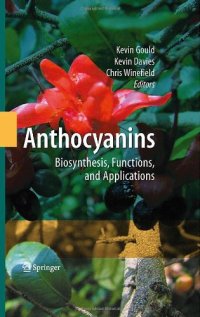
Ebook: Anthocyanins: Biosynthesis, Functions, and Applications
Author: Jean-Hugues B. Hatier Kevin S. Gould (auth.) Chris Winefield Kevin Davies Kevin Gould (eds.)
- Genre: Mathematics // Applied Mathematicsematics
- Tags: Plant Biochemistry, Nutrition, Food Science, Plant Sciences
- Year: 2009
- Publisher: Springer-Verlag New York
- Edition: 1
- Language: English
- pdf
In recent years, knowledge of anthocyanin pigments has undergone unprecedented expansion. Indeed, the molecular genetic control of anthocyanin biosynthesis is now one of the best understood of all secondary metabolic pathways. Advances in analytical technology have led to the discovery of many novel anthocyanin compounds, dramatically enriching the palette used by plant breeders to introduce vibrant new colors into horticultural crops. The food industry, too, has benefited from this research; methods for stabilizing the colors of anthocyanins extracted from cell cultures have been optimized, opening the way for their use as natural food colorings.
Recent scientific research has also focused on the possible benefits to human health from the ingestion of anthocyanin-rich foods. Anthocyanins are remarkably potent antioxidants. These pigments, especially in conjunction with other flavonoids, have been associated with reductions in the incidence and severity of many other non-infectious diseases, including diabetes, cardiovascular disease and certain cancers.
Finally, there has been significant progress in our understanding of the benefits of anthocyanins to plants themselves. Originally considered an extravagance without a purpose, anthocyanins are now implicated in multifarious vital functions. These include the attraction of pollinators and frugivores, defense from herbivores, and protection from environmental stressors. Anthocyanins are highly versatile and enormously useful to plants.
This book covers the biosynthesis and function of anthocyanins (and the related proanthocyanidins) in plants, and their applications in agriculture, food products, and human health. The book addresses wide-ranging issues that include human nutrition, the pastoral sector, cell culture production systems, food colorants, flower and fruit color, plant biotic interactions, and the responses of plants to environmental stress.
Kevin Gouldis an Associate Professor in Biological Sciences at Victoria University of Wellington, New Zealand, where he teaches plant development and physiological plant ecology. He has a long-standing research interest in the functional significance of anthocyanins in leaves, stems and roots.
Chris Winefieldis a Senior Lecturer in Plant Biotechnology and Biochemistry at Lincoln University, New Zealand, where he teaches plant biochemistry and biotechnology applications in modern plant biology. He has a long-standing research interest in the metabolism and molecular biology of plant secondary metabolites, especially the production of anthocyanins in ornamental flower crops. Latterly he has begun work characterizing metabolic pathways responsible for the formation of flavor and aroma compounds in wine grape.
Kevin Daviesleads the Plant Pigments Team of Crop & Food Research, Palmerston North, New Zealand. His group studies the molecular genetics of pigment biosynthesis in ornamentals, fruit and vegetables. A particular interest is the transcriptional regulation of flavonoid biosynthesis.
In recent years there has been an unprecedented expansion of knowledge about anthocyanins pigments. Indeed, the molecular genetic control of anthocyanins biosynthesis is now one of the best understood of all secondary metabolic pathways. There have also been substantial improvements in analytical technology that have led to the discovery of novel anthocyanin compounds. Armed with this knowledge and the tools for genetic engineering, plant breeders are now introducing vibrant new colors into horticultural crops. The food industry has also benefited from the resurgence of interest in anthocyanins. A greater understanding of the chemistry of these pigments has led to improved methods for stabilizing the color of anthocyanins extracts, so that they are more useful as food colorings. Methods for the bulk production of anthocyanins from cell cultures have been optimized for this purpose. Possible benefits to human health from the ingestion of anthocyanin-rich foods have also been a major feature of the recent scientific literature. Anthocyanins are remarkably potent antioxidants, and their ingestion has been postulated to stave off the effects of oxidative stress. These pigments, especially in conjunction with other flavonoids, have been associated with reductions in the incidence and severity of many other non-infectious diseases, including diabetes, cardiovascular disease and certain cancers. An industry is developing around anthocyanins as nutritional supplements. Finally, there has been significant progress in our understanding of the benefits of anthocyanins to plants themselves. Originally considered an extravagance without a purpose, anthocyanins are now implicated in multifarious vital functions. These include the attraction of pollinators and frugivores, aposematic defense from herbivores, and protection from environmental stressors such as strong light, UVB, drought, and free radical attacks. Anthocyanins are evidently highly versatile, and enormously useful to plants. This book covers all aspects of the biosynthesis and function of anthocyanins (and related compounds such as proanthocyanidins) in plants, and their applications in agriculture, food products, and human health. Featured areas include their relevance to: * Plant stress * Flower and fruit color * Human health * Wine quality and health attributes * Food colorants and ingredients * Cell culture production systems * The pastoral sector